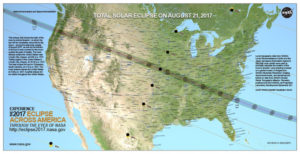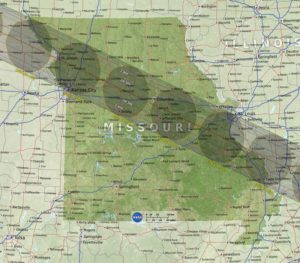During a total solar eclipse, animals can behave strangely. Chickens head home to roost. Birds stop singing. Frogs start croaking. Geese may change their direction of flight. However, according to St. Louis Science Center Planetarium astronomer Eric Gustafson, the animal that will behave the most strangely, is the human being.
The awe-inspiring event will have a big impact on those who experience it. “Each person will have a different reaction,” says Gustafson. “It’s going to be amazing.”
At 1:17 pm August 21, 2017, one of the most anticipated astronomical events in years will occur as a total solar eclipse passes through the St. Louis area on its diagonal path across the U.S. It is being hailed as the Great American Eclipse.
 Other than the personal impact of the eclipse, what makes the Aug. 21 total eclipse special is that it will sweep across the U.S. and no other country. The last continent-wide eclipse visible only from the U.S. was in 1776, and our last coast-to-coast total solar eclipse occurred 99 years ago. For St. Louisans, it is an event of a lifetime. The last total solar eclipse in the greater St. Louis area was 575 years ago, in 1442. The next will occur 488 years from now, in 2505.
Other than the personal impact of the eclipse, what makes the Aug. 21 total eclipse special is that it will sweep across the U.S. and no other country. The last continent-wide eclipse visible only from the U.S. was in 1776, and our last coast-to-coast total solar eclipse occurred 99 years ago. For St. Louisans, it is an event of a lifetime. The last total solar eclipse in the greater St. Louis area was 575 years ago, in 1442. The next will occur 488 years from now, in 2505.
Unusual Phenomena. A total solar eclipse occurs when the Moon passes between the Earth and the Sun, blocking the Sun from view and casting a shadow on the Earth. The inner, darkest part of that shadow, the umbra, is where you will see total blockage of the Sun. You must be in this path of “totality” to witness a total solar eclipse. The penumbra, the surrounding, outer shadow is where you will only see a partial eclipse of the Sun. (See here for details on the “cosmic coincidence” that allows for a total solar eclipse.)
 The path of totality for the Aug. 21 solar eclipse will be a narrow, 67-mile-wide ribbon that cuts across the nation from west to east. The Moon’s shadow will first touch the U.S. at Lincoln Beach, Oregon. From there, the shadow races 2500 miles to Charleston, South Carolina, where it exits the continent in just 94 minutes (~1600 mph). All of North America and parts of South America, Europe and Africa will witness at least a partial eclipse.
The path of totality for the Aug. 21 solar eclipse will be a narrow, 67-mile-wide ribbon that cuts across the nation from west to east. The Moon’s shadow will first touch the U.S. at Lincoln Beach, Oregon. From there, the shadow races 2500 miles to Charleston, South Carolina, where it exits the continent in just 94 minutes (~1600 mph). All of North America and parts of South America, Europe and Africa will witness at least a partial eclipse.
If you are in the area of totality, be prepared to witness unusual phenomena. Darkness will fall. The temperature may drop anywhere from 5-15 degrees. The breeze may vanish or change direction, nocturnal insects will emerge, and yes, animals may act confused or in a strange manner. Stars and planets will be visible. “We may be able to see 4 planets, but most likely Jupiter and Venus, and a handful of bright stars,” says Gustafson. “You will see the corona, the atmosphere of the Sun. There will be an eerie twilight on the horizon.”
 So Close to the Edge. The umbra will slice across Saint Louis, cutting the city in half. The edge of totality will just graze the area of Forest Park. “Unfortunately, the Barnes complex will be out of the totality,” says Gustafson. “… so close to the edge.” There, people will see only a partial eclipse, in which 99.9% of the Sun is blocked. Only one small corner in southwest Forest Park will be in totality.
So Close to the Edge. The umbra will slice across Saint Louis, cutting the city in half. The edge of totality will just graze the area of Forest Park. “Unfortunately, the Barnes complex will be out of the totality,” says Gustafson. “… so close to the edge.” There, people will see only a partial eclipse, in which 99.9% of the Sun is blocked. Only one small corner in southwest Forest Park will be in totality.
While the difference between 100% and 99.9% doesn’t sound like much, in reality, it makes a big difference. Gustafson points out that there is a fine line of totality. “Either you are in or you are out. You see it, or you don’t.” For instance, the area south of Wydown Avenue in Clayton will be in totality. North of Wydown, you will see a partial eclipse. However, he points out that even in a partial eclipse one may see shadow bands (“undulating shadows” or “eddies of sunshine”) on a white wall or pavement. Click on NASA’s interactive map to see the path of totality.
While totality lasts only minutes, the whole eclipse event will last nearly 3 hours. In the St. Louis area, the eclipse will start at 11:49 am when the Moon starts to block the Sun. “It will look like a bite out of a cookie,” says Gustafson. The Sun is then gradually “eaten up” and totality takes place at 1:17 pm. The eclipse ends 2:44 pm.
Where To See Totality. In the immediate St. Louis area, the duration of totality will vary greatly, a few seconds to over two minutes, depending where you are. For example: Clayton will see totality for 19 seconds; Richmond Heights, 38 seconds; Shrewsbury, 1 minute, 12 seconds; Downtown and Florissant, 0 seconds. To find out if you will be in an area of totality, and for how long, see the searchable database on the StLouisEclipse2017.org website.
Jefferson City, MO, and Carbondale, IL, have been designated as two of the best nearby cities within the eclipse’s path of totality to watch the event. In Jefferson City, totality begins at 1:13 pm and lasts for two-and-a-half minutes. NASA determined that the greatest point of duration of the eclipse will be near Carbondale, about 100 miles southeast of St. Louis, where totality will last two minutes and 40 seconds, starting at 1:20 pm.
Savor the Experience. One tip Eric Gustafson has for viewing the eclipse is to slow down and pay attention to what is happening around you. Enjoy the experience. He encourages you to record what you are thinking and feeling as the experience unfolds. Then play back the recordings with your friends. Each will be unique. “It will be a personal experience,” he says. “It will be so amazing, time will fly by.”
For those unable to physically experience the eclipse, NASA will livestream the event. In fact, NASA TV has chosen Jefferson City as one of seven locations across the U.S. from which to broadcast.
As for Eric Gustafson, he will be in Festus, MO. Duration of totality: 2 minutes, 36 seconds!
More Information: NASA Total Eclipse 2017; The Great American Eclipse; Space.Com 2017 Eclipse. For St Louis Science Center eclipse activities, visit here. See Eric Gustafson and the “Great Lunar Coverup” here.
Eye safety suggestions for viewing a solar eclipse here.
How to photograph the eclipse safely at the NASA eclipse site.
How to photograph time-lapse photos of the eclipse at USA Today.
Washington University Eclipse Viewings Include Ice Cream and Goggles
University College in Arts & Sciences will sponsor a Total Solar Eclipse Ice Cream & Viewing Social, at Mudd Field, Danforth campus, 12:00 to 1:45 pm, on Aug. 21. Guests who RSVP will receive eclipse eye protection glasses. RSVP at ucollege.wustl.edu/eclipse
Visit us on Facebook @WUSTLNephrology and tell us about your eclipse experience. Happy viewing!